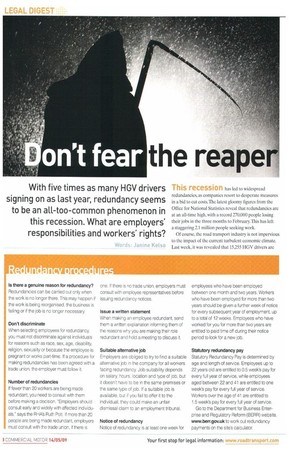-1•1 • • '•
Page 28

Page 29

If you've noticed an error in this article please click here to report it so we can fix it.
Is there a genuine reason for redundancy? Redundancies can be carried out only when the work is no longer there. This may happen if the work is being reorganised, the business is failing or if the job is no longer necessary.
Don't discriminate When selecting employees for redundancy, you must not discriminate against individuals for reasons such as race, sex, age, disability, religion, sexuality or because the employee is pregnant or works part-time. If a procedure for making redundancies has been agreed with a trade union, the employer must follow it.
Number of redundancies If fewer than 20 workers are being made redundant, you need to consult with them before making a decision. "Employers should consult early and widely with affected individuals," says the RHA's Ruth Pott. If more than 20 people are being made redundant, employers must consult with the trade union, if there is one. If there is no trade union, employers must consult with employee representatives before issuing redundancy notices.
Issue a written statement When making an employee redundant, send them a written explanation informing them of the reasons why you are making their role redundant and hold a meeting to discuss it.
Suitable alternative job Employers are obliged to try to find a suitable alternative job in the company for all workers facing redundancy. Job suitability depends on salary, hours. location and type of job, but it doesn't have to be in the same premises or the same type of job. If a suitable job is available, but if you fail to offer it to the individual, they could make an unfair dismissal claim to an employment tribunal.
Notice of redundancy Notice of redundancy is at least one week for employees who have been employed between one month and two years. Workers who have been employed for more than two years should be given a further week of notice for every subsequent year of employment, up to a total of 12 weeks. Employees who have worked for you for more than two years are entitled to paid time off during their notice period to look for a new job.
Statutory redundancy pay Statutory Redundancy Pay is determined by age and length of service. Employees up to 22 years old are entitled to 0.5 week's pay for every full year of service, while employees aged between 22 and 41 are entitled to one week's pay for every full year of service. Workers over the age of 41 are entitled to 1.5 week's pay for every full year of service.
Go to the Department for Business Enterprise and Regulatory Reform (BERR) website, www.berr.gov.uk to work out redundancy payments on the site's calculator. signing on — an increase from 3,000 in 2008, which saw a 7% downturn in driving jobs compared with 200'7 The United Road Transport Union notes a sharp increase in job cuts in the industry recently, while the Road Haulage Association reports a rise in members seeking advice on redundancy queries.
United Road Transport Union national officer Mel Thornton says: "In some cases, we've seen jobs go because companies that lease-hire vehicles cannot afford to pay for them, so they send them back, leaving the driver in a redundant situation."
Ruth Pott, employment affairs manager for the Road Haulage Association, believes most RHA members arc carrying out redundancy procedures fairly because many seek expert advice front her organisation before taking any drastic measures.
But Thornton thinks many employers are not playing by the rules when it comes to slashing jobs. "Some companies do carry out redundancies fairly, while others terminate the employment of drivers using the matrix system, which lacks any hard or fast rules," she says.
Employees' value
The matrix system is used by employers to determine an employees' value to the company, taking into account factors such as qualifications, time-keeping and absence. In theory, this system is fair, balanced and non-discriminatory.
Thornton adds: "The matrix system is supposed to be objective, but it's often not when put into practice."
Employers should also think carefully about the future of the industry before slashing jobs, "The average age of drivers across the country is high, so those being made redundant now will not come back into an industry that needs a major overhaul," Thornton warns. "Also, young people will not come into an industry where employees have to spend several nights away from home and work on a shift system that includes weekends and bank holidays."
Pott says employers should consider alternative ways of making budget cuts that do not involve reducing staff, such as shorter working hours or voluntary sabbaticals.
The Chartered Institute of Personnel and Development also argues that businesses should avoid redundancies, not least because redundancy does not come cheap.
The average cost of making one employee redundant is estimated to be /16,000.That said, if the work is falling away and your only option is to make drivers and other staff redundant, we explain how to carry out the process fairly and within the boundaries of the law (see panel on the opposite page).












































































































































